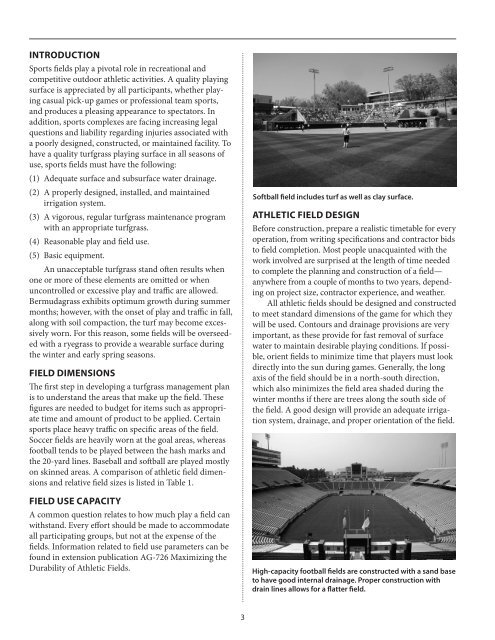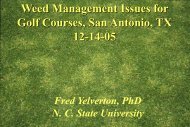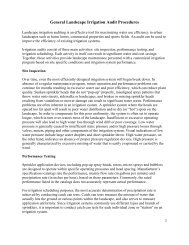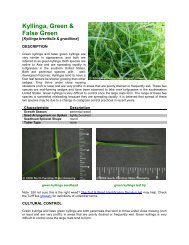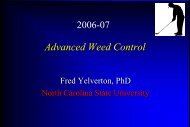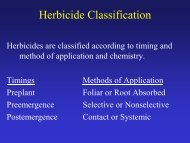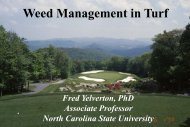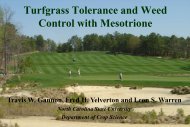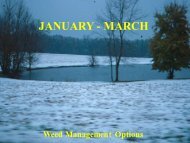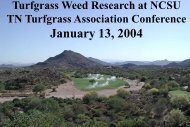Carolina Athletic Fields: - TurfFiles - North Carolina State University
Carolina Athletic Fields: - TurfFiles - North Carolina State University
Carolina Athletic Fields: - TurfFiles - North Carolina State University
- No tags were found...
Create successful ePaper yourself
Turn your PDF publications into a flip-book with our unique Google optimized e-Paper software.
INTRODUCTIONSports fields play a pivotal role in recreational andcompetitive outdoor athletic activities. A quality playingsurface is appreciated by all participants, whether playingcasual pick-up games or professional team sports,and produces a pleasing appearance to spectators. Inaddition, sports complexes are facing increasing legalquestions and liability regarding injuries associated witha poorly designed, constructed, or maintained facility. Tohave a quality turfgrass playing surface in all seasons ofuse, sports fields must have the following:(1) Adequate surface and subsurface water drainage.(2) A properly designed, installed, and maintainedirrigation system.(3) A vigorous, regular turfgrass maintenance programwith an appropriate turfgrass.(4) Reasonable play and field use.(5) Basic equipment.An unacceptable turfgrass stand often results whenone or more of these elements are omitted or whenuncontrolled or excessive play and traffic are allowed.Bermudagrass exhibits optimum growth during summermonths; however, with the onset of play and traffic in fall,along with soil compaction, the turf may become excessivelyworn. For this reason, some fields will be overseededwith a ryegrass to provide a wearable surface duringthe winter and early spring seasons.FIELD DIMENSIONSThe first step in developing a turfgrass management planis to understand the areas that make up the field. Thesefigures are needed to budget for items such as appropriatetime and amount of product to be applied. Certainsports place heavy traffic on specific areas of the field.Soccer fields are heavily worn at the goal areas, whereasfootball tends to be played between the hash marks andthe 20-yard lines. Baseball and softball are played mostlyon skinned areas. A comparison of athletic field dimensionsand relative field sizes is listed in Table 1.FIELD USE CAPACITYA common question relates to how much play a field canwithstand. Every effort should be made to accommodateall participating groups, but not at the expense of thefields. Information related to field use parameters can befound in extension publication AG-726 Maximizing theDurability of <strong>Athletic</strong> <strong>Fields</strong>.Softball field includes turf as well as clay surface.ATHLETIC FIELD DESIGNBefore construction, prepare a realistic timetable for everyoperation, from writing specifications and contractor bidsto field completion. Most people unacquainted with thework involved are surprised at the length of time neededto complete the planning and construction of a field—anywhere from a couple of months to two years, dependingon project size, contractor experience, and weather.All athletic fields should be designed and constructedto meet standard dimensions of the game for which theywill be used. Contours and drainage provisions are veryimportant, as these provide for fast removal of surfacewater to maintain desirable playing conditions. If possible,orient fields to minimize time that players must lookdirectly into the sun during games. Generally, the longaxis of the field should be in a north-south direction,which also minimizes the field area shaded during thewinter months if there are trees along the south side ofthe field. A good design will provide an adequate irrigationsystem, drainage, and proper orientation of the field.High-capacity football fields are constructed with a sand baseto have good internal drainage. Proper construction withdrain lines allows for a flatter field.3


